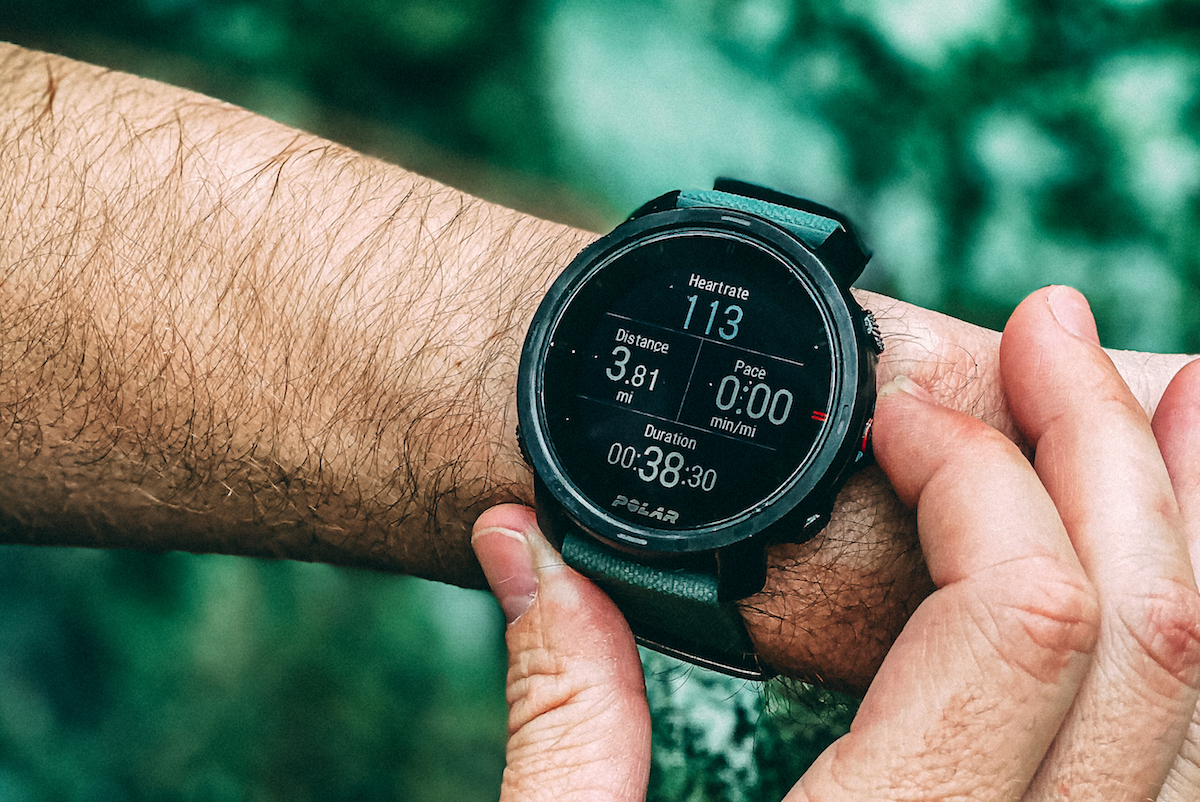
ROBBE: It’s 2020, and while races are postponed for the time being, it’s evident that people are trying to do more and be more than ever before. The marathon distance, long a goal of runners everywhere, has now become a stepping stone to distances of 50 miles, 100 miles, and more. And while ultrarunning has certainly picked up steam in the last decade, the battery life in GPS devices used by ultrarunners was lacking. Until recently, watches couldn’t cover 24 hours of GPS on one charge. Oftentimes, ultrarunners would have to carry backup power and charging cable if they wanted a continual GPS track.
Of course, times change, tech improves, things get smaller, and (hopefully) better. There are a number of watches that can typically cover most ultras at this point, from the COROS Vertix (60 hrs) and APEX Pro (40 hrs) to the Garmin Forerunner 945 (36 hrs). And of course, user options keep coming too, from contactless payment to music and more. No longer does a GPS watch just track GPS.
Polar has been around for awhile, and they know that to keep up, you need to keep ahead. They’ve seen the surge of interest in outdoor adventure and ultrarunning and set out to make a watch that caters to those crowds.
Behold, the Polar Grit X.
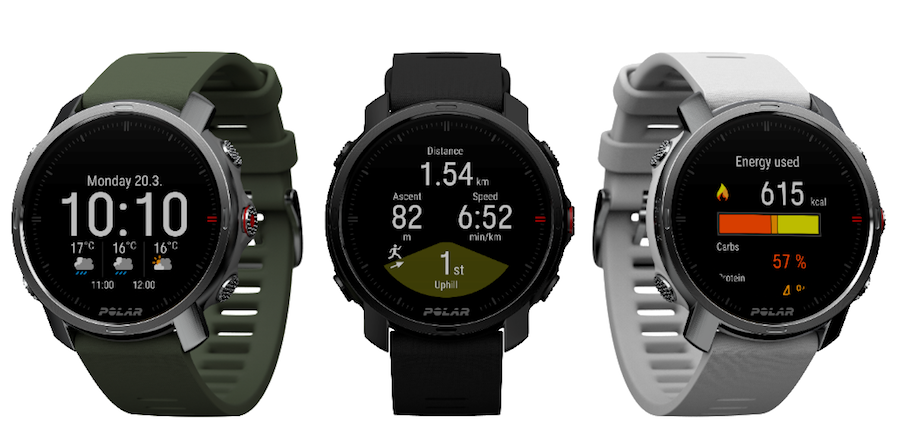
Baseline options of the Polar Grit X
We first heard about the Grit X (and saw early models of it) back in December at The Running Event. Coming off some recent reviews of COROS watches targeted at ultrarunners, my interest was immediately piqued. So I was excited to get the final product in my hands a couple weeks ago, after a few weeks of production delays due to the novel coronavirus.
I’ll give you the short pitch from Polar, then I’ll get into the details and see how it holds up.
The Polar Grit X is an outdoor multisport watch designed to be rugged and durable, yet lightweight (64 g), with top training features. The watch has passed several US military-grade tests including extreme temperatures, drops, and humidity, and features a battery life that delivers 40 hours of continuous GPS battery life.
The Grit X has new features from Polar, including nutrition alerts, hill splitter, route planning (via Komoot), and weather forecast from the wrist.
Other smart coaching features include Polar’s Precision Prime heart rate monitoring, FitSpark workouts from the watch, nightly recharge, built-in running power, and more.
Sound good so far? Let’s keep going. (NOTE: Throughout this review, I will make multiple comparisons against the Garmin 945 and COROS Apex Pro, as these are the two closest class comparisons to the Grit X).
Let’s get the tech specs out of the way. Size is always important with watches, in other areas of life it’s always up for debate. Bigger is not always better. That said, the Polar Grit X does come in on the larger side of things. However, it’s not too big and even I can wear the watch (I promise you I have the smallest wrists of any grown man you know). But it is on the high end in size at 47 x 47 x 13 mm for the case measurements. I’m also not sure that these measurements are correct because the Grit X is at least a millimeter thicker than the Garmin 945 and COROS Apex Pro, both of which have the same spec measurements.
The case is made of stainless steel with a glass fiber reinforced back cover, while the display lens is made from Gorilla glass (more on this later). Watch strap is silicone, with a variety of options, including military green (which I received). It’s compatible with any 22 mm quick release band, which is nice. The case also comes in stainless steel or black.
Comfort-wise, I had no issues whatsoever. And despite the somewhat thick case, I didn’t find it to be obtrusive.
The watch weighs 64 grams, which isn’t light, but it’s not ridiculous. In comparison, the COROS Apex Pro weighs 59 grams. However, the Grit X is about 30% heavier than the Garmin 945.
Shop Polar Grit XFirst, the nutrition reminders. Very useful, especially in longer events when you don’t realize you’re in the weeds until it’s too late. You can now set fuel reminders at specified intervals (like, every 45 minutes), as well as drink reminders. You can do this manually or allow Polar’s “smart fueling” to discern your carb intake based on your body type and training. I don’t know that I’ll ever need the drink reminders, but in longer races I’m down to get some nutrition nudges.
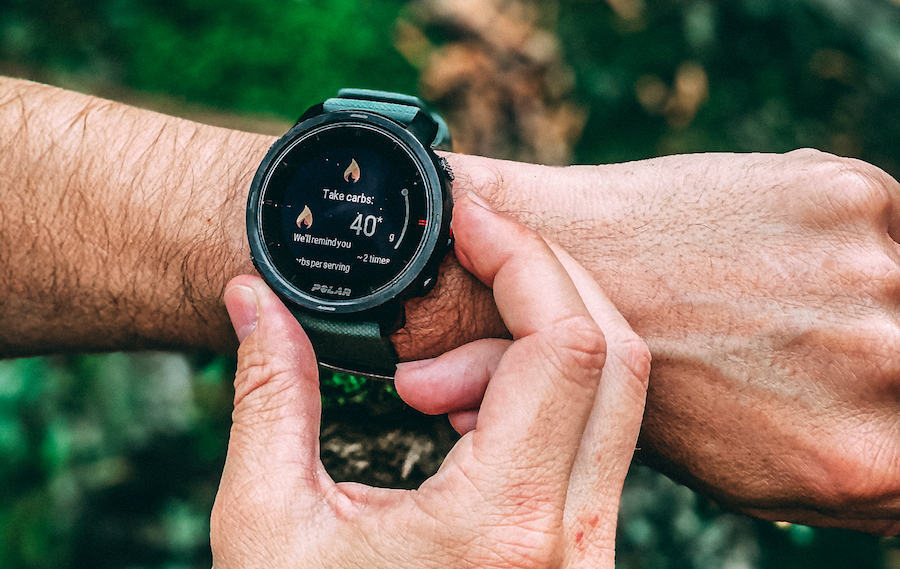
Smart Carb Reminder
Love me some route guidance because I like exploring weird places or new trails. Now, Polar doesn’t have its own map system unlike that other giant GPS company, so it uses a 3rd party integration to plan routes. Of course, you can upload any GPX or TCX file into the Polar Flow website and use that route, but to actually plan one out and have it sync to your device, you have to go through a company called Komoot.
I personally had never heard of Komoot, but it’s basically a mapping platform where you can see and download other users’ routes or create your own. It’s actually a very nice interface and I mapped out a route fairly quickly using drag and drop sections. If you have the Komoot app, you can set it to integrate with the Polar Flow app so that any routes you create are loaded into Polar Flow, and when you sync your watch– boom– they’re now on your wrist.
(For more details on this integration and Komoot, check out the Komoot/Polar page.)
Now, the problem with Komoot is that you can only access one locale for free– after that you you must pay the piper. Obviously this can be a deterrent.
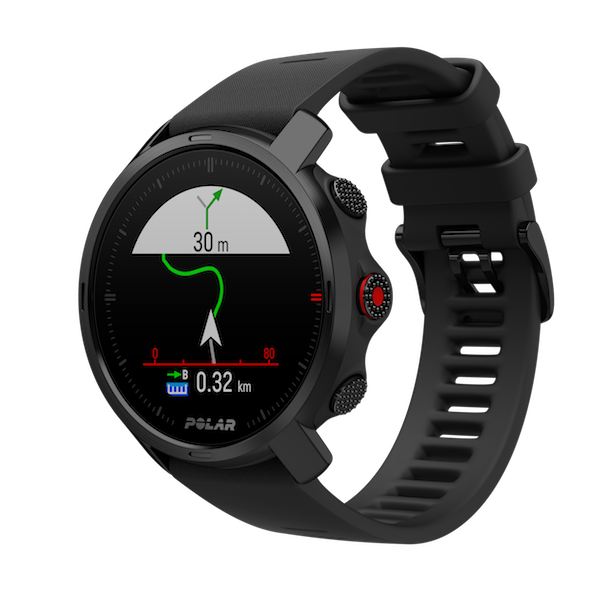
In any case, I did create some routes on my own to test out with the Grit X. When the route is loaded, you have the option of starting from the beginning or end (or middle), depending where you are or if it’s a loop route. Now, you will not get a street view on here, which can become slightly disorienting. The route does show you where you’re going and when a turn is coming up, but if you miss that turn and keep going for a little while, you’re suddenly in black space. An arrow will tell you which way to go back and how far, but it’s still somewhat hard to get your bearings, especially if you’re in a highly-trafficked place with unblazed trails or in a city (you won’t see any street names on the watch).
Full disclosure, I lost the route both times, but both times were also on poorly marked trails in areas with all kinds of trail shoot-offs that made it confusing. At one point I had to cross a creek but the creek didn’t show on the route map, so I had no idea where I was supposed to go and ended up scrapping the route and using my phone.
I will say, I was able to find my way back to the correct route in other situations where I went too far without realizing where I was running. One other thing I really didn’t like– you couldn’t zoom in or out on the map to get a better overall view of where you were. That needs to be in a future update, in my opinion.
This honestly might be my favorite thing on the watch, because I haven’t seen it in other watches (maybe I haven’t been looking) and it’s super useful. You can actually see the weather report from the watch face, and there’s even a watch face setting where, instead of numbers of a clock, it’ll show the weather for each hour. Pretty slick.
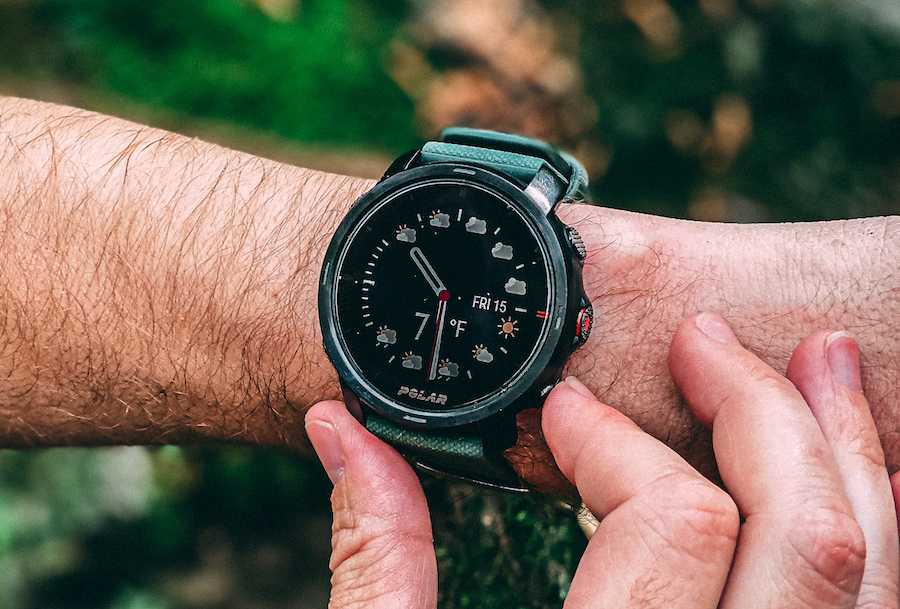
Hourly Weather Report
I’m going to be completely honest, I didn’t even use this function. Mainly because I’m not running any significant hills right now, either in training or on runs. But essentially, the hill splitter functionality allows you to analyze both uphill and downhill performance by– you guessed it– detecting uphills and downhills and splitting their stats into two comparable categories. Personally, I don’t care about this– in training, I run hard uphill, I take it easy downhill, and in races, I do the opposite.
However, for ultra runners or mountain runners, I can see how this would be advantageous to training.
Pre-loaded to the watch are a variety of workouts– you know, the kind that you’d rather stick needles in your eyes than do because you’re a runner. But it actually customizes a plan for you and suggest doing these workouts, even going so far as to provide animated images to show you how to perform them. You can then do a guided workout (i.e. core, mobility) straight from the watch with notifications of when to switch between exercises. It’s actually a pretty cool feature that’s on there for free.
Shop Polar Grit XLike I mentioned earlier, I wasn’t exactly writing love letters to the design of Polar’s previous models. They were fine, but they looked too much like fitness watches. Kudos to the design team for changing that up. The Grit X is a badass looking piece of machinery, and it’s something I enjoy wearing all the time. If you’re going to make a rugged watch, it better look like it belongs in the outdoors. There’s a bunch of strap options coming for this watch as well, anything from leather to tree camo.
The buttons are overhauled from other Polar models, and I have to say, it’s really great. Instead of a smooth, stiff button that’s not touch-friendly, the new buttons are large with a textured grip on them. It really allows you to feel the buttons and may be my favorite button feel of any watch I’ve tested.

Polar Grit X – Black Case w/ Swapped Out Miltary Green Strap
Now, I still have issues with the graphic display in terms of design. It’s literally the same as the Vantage series, which was lacking. The actual activity screens are clean and the screen brightness is adequate, but the text just looks outdated. This probably doesn’t matter to 99% of users, but it’s something that sticks in my craw. Also, why are there no other faces for the screen other than just analog and digital? It’s the same screen as the Vantage V. People want options.
The UI/UX is also still the same as the Vantage V, which is to say, not super intuitive. Like, any watch or piece of technology, there’s a learning curve, but it’s a bit too steep. More on that later.
Okay, so this is a big one for me. What I want in a watch are three things: 1) solid battery (I’m one of those people whose phone is always at 10% because I hate charging things), 2) quick and accurate GPS connection, and 3) fast data transfer. That’s it. Yes, I like extra things, but those are the most important to me.
Clearly I was excited when I saw that Polar had a 40-hour full GPS model that was geared toward trail running/adventuring. I’ve had the watch for a few weeks now, I started with a full charge, took it to zero, then charged it the whole way back.
The settings were as follows: continuous HR, screen light on motion, GPS tracking every second. I didn’t wear the watch at night because I can’t sleep with a watch on.
I did a couple run-throughs, just starting an activity and letting it run until the battery died. The total activity time was just short of 35 hours before it cut off and saved (which happens when the watch has 5% battery life left). I understand saving an activity before the watch dies, but it still kind of drives me crazy that you can’t override it and keep recording until it gets to, say, 1% battery life. Still, it’s better than previous Polar watches, which would cut off your recording at 10% battery life. So it didn’t quite get to that 40-hour life. Equally annoying, straight off a full charge I’d start an activity and the estimated battery life was always 36 hours. Not sure what was going on there.
All that to say, with continuous HR on and 1-second GPS tracking, you’re not going to get the full 40 hours of life. However, I did compare it against my COROS Apex Pro (another 40-hour watch), and the Apex Pro died at exactly 30 hours of activity on the same settings. That said, I have had that watch for almost 9 months of daily usage, so some battery loss is expected. This was a head-to-head test, where I started both watches at the same time off full charges on opposite wrists. I looked and felt ridiculous if I’m going to be honest. My neighbor even called me out on it.
Now, my suspicion is that the battery drain on the Grit X comes mostly from the optical heart rate monitor. The Grit X has 10 lights firing off, more than any other watch (and more than the Vantage V), which is great for lighting up your blood flow, but not so awesome on the battery.
All that to say, Polar does claim the watch only gets 1 week of normal usage on a full charge, so that seems to hold up.
One other thing to point out that’s often overlooked: In an extended situation, you could still charge this watch while wearing it, because of the flat disc design of the charger. It can lay flat against your wrist if you really need to.
This is the big one. In the past, Polar has always performed exceptionally well in all head to head tests. Even with the M430, I never had any issues with GPS over the entire year that I used it for training. If I think about it, Polar has been the most reliable of any GPS watch I’ve used. Almost as reliable as that knock-knock joke I tell at all those parties that I’m not invited to anymore.
The Grit X was no different. I did multiple tests vs. Garmin 945, COROS Apex Pro, and Polar Vantage V, and it was spot on almost every time, with the exception of one minor drop as you’ll see below. However, I’ve had no major drops over the last four weeks of testing.
Devices: Polar Grit X, COROS APEX Pro, Garmin Forerunner 945
Geography: Cemetery next to a truck stop cause why the f not
As you can see, all three watches are pretty spot on. On the right side, the Grit X is actually more accurate, but generally pleased with all of them. This was a 7.25 km run and all watches finished within .10 km of each other.
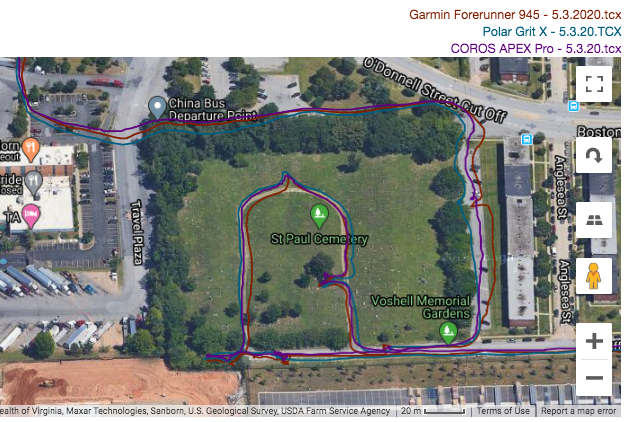
Devices: Polar Grit X, COROS APEX Pro
Geography: City
On this one, you do see a slight drop from the Grit X in the bottom left corner (the unusally straight line). I ran into a parking area beneath an abandoned factory and it lost it, but picked up quickly when I came out the other side. The rest of the run was fine, and both watches ended within .10 km of each other.
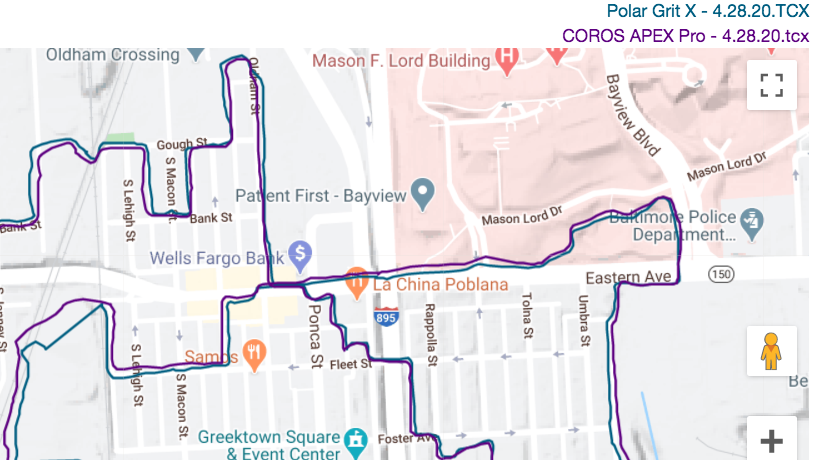
Devices: Polar Grit X, Polar Vantage V, COROS APEX Pro, Garmin Forerunner 945
Geography: Mix of trail and suburb
I got crazy lost in this section that was also really shady (and not like in a tree coverage way). Lots of burned-out cars from people hiding crimes, dirt bike crew buzzing around, and lost my bearings cause there’s no trail markings. As you can see I was going back and forth looking for a trail segment that I didn’t know crossed a creek. In any case, all watches remained fairly tight with each other throughout.
At the end of this run, all watches were right at 12 km, except for the COROS Apex Pro which was at 12.4.
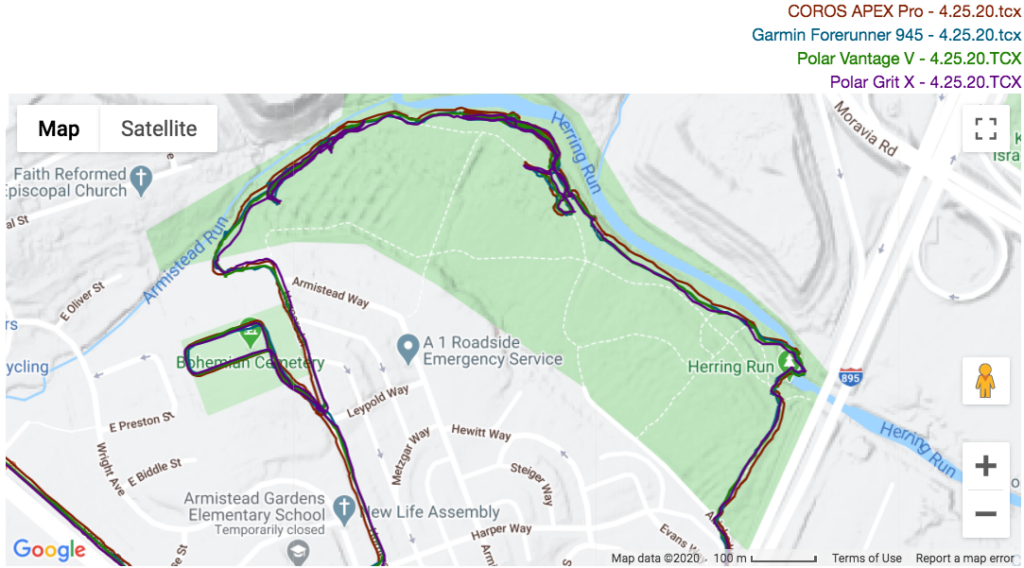
I don’t even know why I include this in reviews, because if you really care about heart rate, you’ll buy a chest strap monitor and use that (like the Polar H10, which I’ve been using the last 9 months). It doesn’t matter who makes what claims, you’ll never get perfect accuracy from an optical heart rate monitor. However, that won’t stop Polar from trying, and they’ve been in the heart rate game for over four decades, so they know something about it.
The Grit X has even more heart rate sensors (10 lights to be exact) on the undercarriage, meaning your blood flow will be lit up like a Christmas Tree decorated with Roman Candles.
Heart rate monitoring can be set to continuous or nightly. I actually wish there was another option, like say– once a minute or every thirty seconds, because those little lights do a number on the battery. Or, why can’t I just turn it off? If you want to extend your battery life, switch it to night only and use a chest strap heart rate monitor during activity.
See below for comparisons.
Devices: Polar Grit X (blue), Garmin Forerunner 945 (red), Polar H10 Chest Strap HRM (purple)
As you can see, everything correlated very well here for the most part. No crazy spikes or drops. Honestly, a really good tracking by all devices.
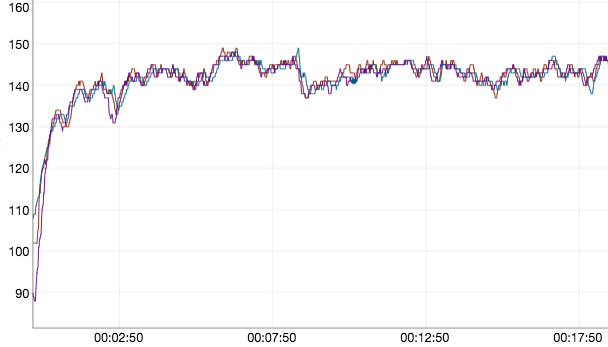
Devices: Polar Grit X (purple), Polar H10 Chest Strap HRM (green), COROS APEX Pro (red)
This one is kind of wild. The baseline is essentially the green line. This was more of an exploring/adventure run so I stopped a bunch to take pictures (as seen by the green valleys). The Grit X actually matched up fairly well, although it did have some spikes. A couple times I looked down and saw it in the high 160s which I knew wasn’t right. Overall, it’s way better than the COROS.
At the end of the run, the average heart rate for both Polar devices was within 1 BPM of each other, while the COROS APEX Pro was 9 bpm less.

The syncing is pretty much the same as the Polar Vantage V or previous models, which is to say, not exactly great, but on par with Garmin. It can sometimes take up to 2 minutes to sync, and although it doesn’t automatically sync when you refresh the app, it actually does automatically sync– just randomly, at some time in the future. It could be hours later and you open Strava and say ‘hey, there’s my group run that I didn’t want to be posted because I’m supposed to be social distancing.’ Well, everyone knows you’re a piece of trash now.
At $430, it’s the lowest price in its class by a good margin. For the battery life, accuracy, training features, design, it’s a very solid price point.
Although enjoyed the Polar Vantage V and Polar M430 in the past, I always thought the designs were kind of lacking. It’s 2020, I want a watch that I can wear all the time without looking like, well… a runner.
So I’m very stoked to say that the product design and comfort in the Grit X is excellent. I love the look of the watch, the feel of the buttons, and the comfort of the wrist strap. It’s very lightweight for its size, so no issues there. Also, the screen is clear and the auto backlight does its job in darker conditions.
This is hands-down my favorite-looking GPS watch right now for under $450, and maybe just in general. I have the black case and swapped out the stock black band for a military green one– I’m not gonna lie, it looks incredible.
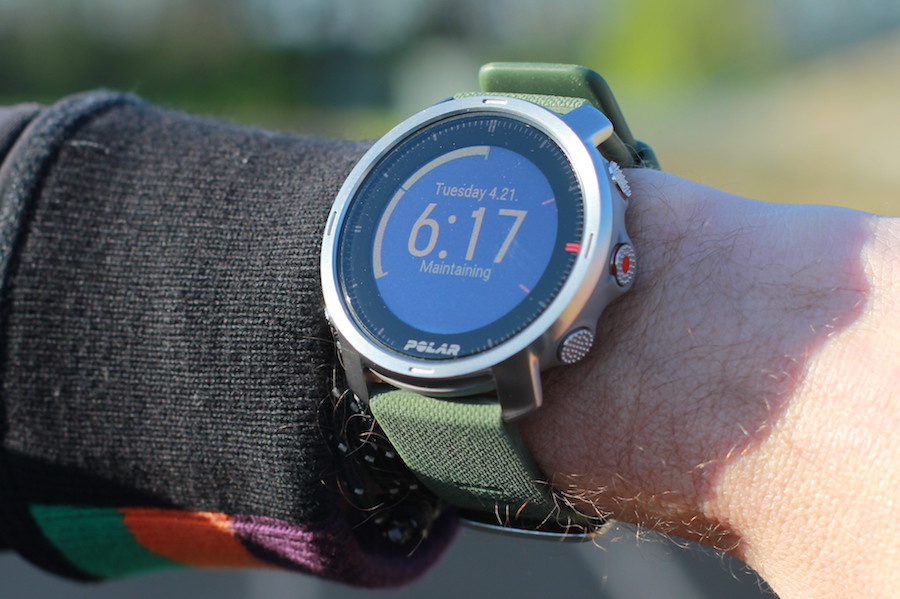
I’ve had Polar watches for over three years now, and I can say this– they are reliable. I’ve never had issues with GPS accuracy, and the heart rate is as solid as you can get for a GPS watch. I’d like to see some updates on the user experience end, but the chassis is solid.
Polar has actually done a fantastic job with the touch screen. It’s very fluid and usable from most fields. From the main face, easily swipe between HR data screen, daily workout totals, weather, etc. It’s definitely the nicest touch screen experience I’ve had from any watch.
To be honest, I didn’t use sleep data on the Grit X, but it’s functionally the same as the Vantage V. It really gives you a nice review of your sleep “performance” with a graphic breakdown on the app.
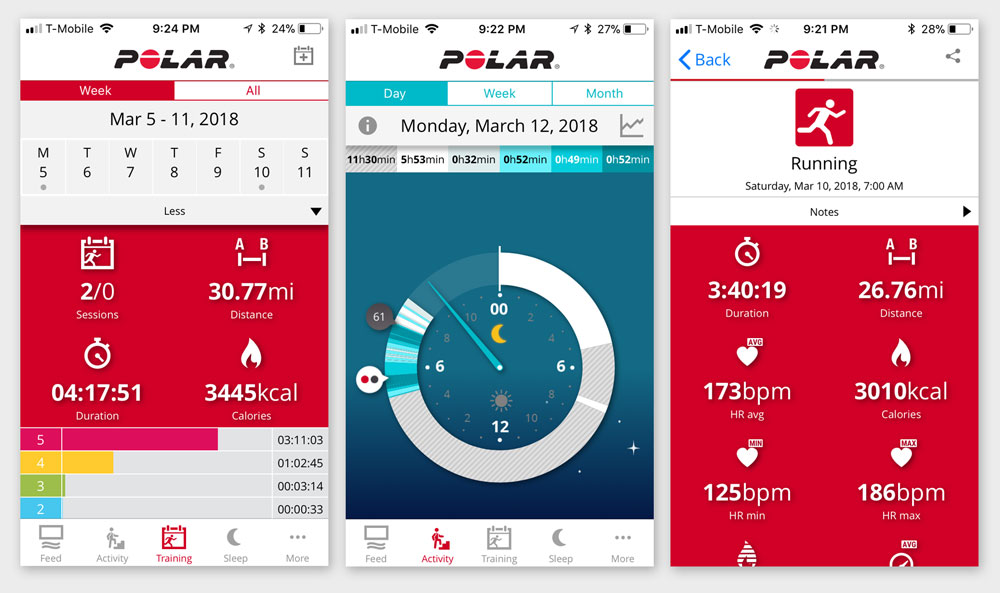
Polar App Data Screens
I have to give this a ding because it’d be dishonest not to. If a watch is going to be rugged, it just can’t use Gorilla Glass for the screen material. Gorilla Glass by Corning is what’s used for iPhone screens, except Apple’s version is proprietary. And you know that even those scratch. On the other hand, sapphire glass is the second hardest material on the planet next to diamond. It’s virtually unscratchable.
All that to say, I already have a noticeable scratch (around 10 mm) on my screen and I’ve had the watch for two weeks, no falls or otherwise hazardous situations. No idea how it happened.
Now, there are downsides to sapphire glass. It’s darker, and anyone with a COROS watch knows this because their screens are almost too dim. It’s also heavier (unsurprisingly) and more expensive, with that cost going to the consumer.
If you accept scratches as part of the package deal, then carry on. But I’d like to see sapphire used in the future.
I’m actually pretty bummed about this, because the app and Polar Flow web application are unchanged. Meaning, it’s been the same app for the last 3 years. While it’s not the worst app ever, it’s far from the best. In short, it’s clunky, crowded, and not user-friendly.
There’s also just common-place things that are stored in weird places. Like, to manually upload a route, you have to go to the favorites tab through the web application, upload it to there, then it’ll sync to your phone, then to your watch. Why is there just not a section for route uploading? I had to Google this to figure it out. Makes no sense.
Also, I complained about this on the Vantage V, but it’s still weird to me that you can’t set heart rate zone alerts unless you jury-rig it through a workout. I just want to stay below a certain heart rate on all my runs, but alas, that functionality is still not there.
One last thing– the watch faces look fine, but let’s get a little creative, okay Polar? There’s more to life than just a digital and analog option– we’re not robots yet.
It doesn’t bother me because I only use one Bluetooth device (my heart rate monitor), but if you’re broadcasting multiple devices, you’re out of luck. Polar has always kind of stuck by their guns on this one, so it doesn’t seem like it’s changing anytime soon.
ROBBE: The Polar Grit X is a solid step forward for Polar. The new functionalities are well-thought-out and provide a well-rounded package for someone who’s serious about their training. I’ve never had issues with Polar’s technology, and over a month of testing have found the watch to be just as solid as my past experiences.
By the way, there are other good features that I wasn’t able to cover in the review, including meditation guidance and Strava Live segments, and more, so make sure to visit the Polar Grit X page to get the full rundown.
Like I said, I’m loving the design and look of the watch, and while I think there are some areas that Polar can still improve on, for $430, this is a really solid option that will give serious runners every tool that they need to excel in their training.
You can pick up the Polar Grit X by using the shop link below.
Shop Polar Grit X
Polar is a sponsor of Believe in the Run; however, all reviews are done independently of any ad buys or sponsorship, otherwise, would we really include a “Bad” section of the review?
Have something to say? Leave a Comment
So, sticking with the Apex Pro huh?
I switch between the two. I love the look of the Grit X, and the accuracy is just as good, so I find myself wearing it more often. I also love the touch screen of the Grit X, very nice to swipe between everything from home (very easy to see daily activities and so on). That said, I much prefer the COROS app and syncing speeds, as well as their track mode.